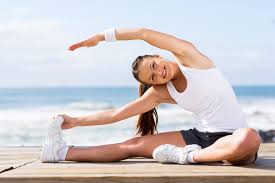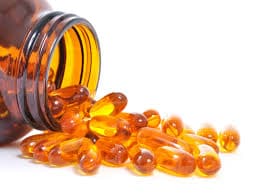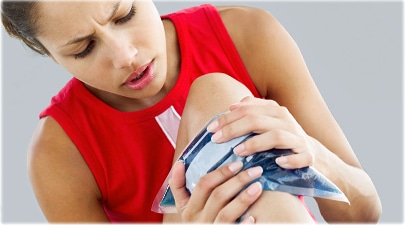
- Get up, stand up.
The more you move around, the less likely you are to suffer from stiffness and pain. If you spend your days sitting at a desk, take breaks to stretch or walk around. Ideally, you should be taking a five-minute break away from your workstation every hour. Set a timer or download an application if you tend to get lost in your work.
The same goes for recreational activities such as reading or watching television. Changing positions often can minimize risk to your bones and joints.
- Choose safety when playing sports.
Avoid bone and joint injuries by wearing padding or protective equipment while rollerblading, skateboarding, or playing sports such as soccer, hockey, or football. If you find that certain joints already ache when you play sports such as golf or tennis, it may help to wear a brace.
- What’s weight got to do with it?
Your size and body type can affect the amount of strain placed on your lower back, hips, and knees. Losing weight—even a little bit—can help. For every single pound you lose, you’ll be taking four pounds of pressure off your knees. Talk to your doctor to find out how to get started.

- Are you making this common stretching mistake?
Most of us stretch before a workout, but you should actually be stretching far more often than that—at least three times per week, if not every single day. Make sure you’re not overstretching when your muscles are cold, as you’ll be more likely to pull something. Instead, spend five to ten minutes gently warming up first. A light walk or jogging on the spot should suffice.
- Low-impact activities are best for your bones and joints.
Engaging in a variety of activities is the best way to ensure you’re not doing damage to your bones or joints. Try to limit high-impact activities such as jogging or running, skipping, stairs, and tennis. Walking, cycling, using an elliptical, rock climbing, pilates, swimming, strength training, and yoga are all examples of low-impact aerobic exercises that won’t cause damage to your bones and joints in the long term.
- Strengthen and tone your muscles to protect your joints.
Strength training is commonly overlooked in fitness routines—especially among women, who also happen to be at an increased risk of developing bone diseases such as osteoporosis. But having strong muscles is one way that you can avoid the effects of weak bones. Talk to a physiotherapist or certified trainer to develop a strength training program and learn the proper techniques. If you already suffer from joint problems, you should avoid fast, repetitive motions.
- Increase your range of motion.
Do your joints feel stiff? Are you inflexible? Range of motion is how far your joints can move in different directions. Talk to a doctor or physiotherapist to learn what exercises you can do to improve your range of motion.

- Develop core strength.
If you tend to ignore the muscles in your abdomen, back, and hips when you strengthen, you’re missing out. Having a strong core helps you to balance, which will decrease your likelihood of slips and falls. Pilates, yoga, and mat exercises can help you to build core strength.
- Find your limits, but don’t exceed them.
A good workout should leave you feeling a little bit sore the next day. But if the aching persists for more than two days, you may have pushed your joints too far. Next time, don’t overdo it. If you experience pain during a workout, pushing through it may lead to joint damage, pulled muscles, or other injuries.
- Your diet can help to reduce inflammation.
You can reduce joint pain caused by inflammation by eating more fish. Oily, cold-water fish like salmon, mackerel, and tuna are all excellent sources of omega-3 fatty acids, which can contribute to healthy joints. They may also target and lower inflammation, one of the main causes of joint pain in people who suffer from rheumatoid arthritis. If you don’t like fish, try fish oil supplements. Other foods that can help to fight inflammation include olive oil, fruits and vegetables, legumes, nuts, and seeds.

- Up your calcium and vitamin D intake for stronger bones.
Most people know they need calcium—from milk and other dairy products—to develop strong bones. But did you know that in order for your body to absorb the calcium you take in, you also need to get enough vitamin D? Also known as the “sunshine vitamin,” studies suggest that most adults aren’t getting enough of it. Talk to your doctor about supplements if you suspect you might not be getting enough calcium or vitamin D.
- Maintain good posture.
If your parents nagged you about sitting up straight when you were a kid, they were right to. Good posture helps to protect all the joints in your body—from your neck to your ankles. If sitting for long periods of time causes your posture to worsen, stand up and take a walk every hour or so. The faster you walk, the harder your muscles have to work to keep you upright. Swimming can also help to improve overall posture.

- Lighten your load.
Don’t forget about the extra load on your joints when you lift and carry things. Purses, grocery bags, messenger bags, knapsacks—even just carrying a wallet can have an effect on your hip and knee joints. Opt for ergonomic bag designs whenever possible. If you’re carrying bags, carry them on your arms instead of with your hands to distribute the weight among bigger muscles and joints.
- Use a cold compress to target joint and muscle pain.
Ice is the cheapest pain reliever around. Note only is it all natural, it will also target aching, inflammation, and swelling. If you have a sore joint, wrap a cold pack, ice cubes, or frozen vegetables in a tea towel and apply it to the site. You can leave it on for up to 20 minutes at a stretch. Do not apply ice directly on your skin.
- Talk to a health professional before you take a supplement.
The supplement aisle at your local pharmacy or grocery store is filled with promises of joint pain relief. But not all supplements have the research to back up their claims. It’s important to remember that supplements—even those that claim to be all natural—are not without side effects. For joint pain relief, glucosamine and SAMe may help. You should talk to a physician before you take supplements, especially if you’re taking medication or suffer from another health condition.

- Treat joint injuries when they happen.
Injuries can cause the cartilage and connective tissue between your joints to erode. If you suffer an injury, see a doctor right away—even if your pain is tolerable. Ask your doctor how you can avoid further damage. You should avoid activities that put excess stress on the joint. Your doctor may recommend a brace while you heal.
- Use orthotics.
If you frequently experience achy knees or hips, orthotic inserts for your shoes may help to alleviate pain. Orthotics are custom-made soles which help to absorb shock when you’re walking or running. Ask your doctor if you think that orthotics might help you.
This page is also available in:
![]() English
English


